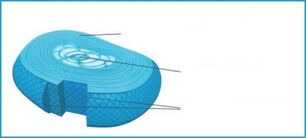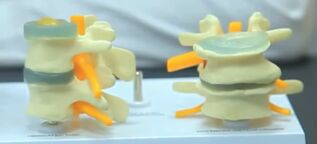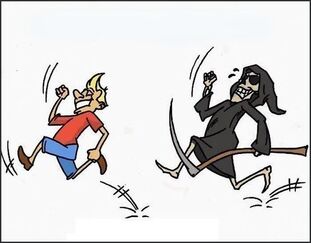Osteochondrosis of the spine: symptoms and treatment, causes, everything has already been said, recounted. That this is not a disease, but the aging of the body, although it is stronger than concrete, it also wears out, gives cracks. Unfortunately, this process of destruction, like old age, cannot be avoided, it only slows down. And most importantly, there are no rejuvenating pills, mixes, powders, apples for osteochondrosis. It is easier to understand, this is a fee, for the fact that we live, we walk, we do some stupid movements, we sit, we sleep. He cannot perform his duties in full force, as in his youth. By the way, about young people, why do they have chondrosis? Here's a quick look at the disease of the 21st century. Let's define the important functions of the column. Let's find out the reasons for the main complications in young people and those who are in years. We will discuss the diagnosis of the disease and the methods of treatment. Let's clarify the basics of prevention and how to save ourselves from rapid aging.
Important column functions
We must not forget that our column has 3 main functions.
- Pivot: keeps the body in a vertical position.
- Protector: protects the spinal cord.
- Cushioning: ligaments and cartilage soften the most varied movements of our body.

The spine absorbs any load in all areas, thanks to the unique intervertebral discs that are located in the structure of the spine.
The concept of the word "osteochondrosis"
The term "osteochondrosis" is used only in Russia, in the West they abandoned this name and instead use the concept of "degenerative disease of the intervertebral disc or cartilage, it can also be called that". This definition reflects the essence of what happens on discs.
Result: yes osteochondrosis - degeneration (dystrophy) of the intervertebral cartilage due to primitive movements. The conclusion of this definition is as follows: dystrophy - a violation of the nutrition of tissues, and degeneration is a change in the tissue for the worse.
Even understanding the meaning of these words, it is clear what is happening in the spine and where such a popular disease, "osteochondrosis", comes from. By the way, what kind of disease is this? Simply, earlier aging.
Degeneration has four stages and stages of development, it develops in the three departments. Osteochondrosis occurs:
- cervical;
- chest;
- lumbar.
Tissue malnutrition
The tissues are nourished by the enormous circulatory system. Arteries, veins, vessels and capillaries, as well as muscle tissue, actively participate in the nutrition process. Along with the blood, the important nutrients that are transported to the vertebrae, cartilage and muscles, when contracting, help the blood to move at the proper speed.
The discs, having no blood vessels, suck water and nutrients at the moment of relaxation of the vertebrae. And when you press on them, the same segments, on the contrary, give away the excess. So it turns out that during the depreciation of the column, due to compression and expansion, the disks are saturated and cleaned by the osmosis method. The more often osmosis occurs, the more satisfying and well-nourished they are.
It is the muscles that surround the vertebrae of the back that carry out the movement process. It is not difficult to imagine if the muscles around the spine are not very mobile, the blood circulation is slow and the entire metabolism is affected. Cartilage suffers from a lack of nutrition, and cannot be elastic and strong, so spinal dystrophy develops.
In the early stages of dystrophy, the incorporation of regular athletic movement into life can still be corrected fairly quickly. The younger generation is hoping for a complete cure.
What happens next? For a long time, being in a state of immobility, the muscles weaken, the ligaments stretch and atrophy to such an extent that they cannot keep the spine in a uniform anatomical shape, various types of curvature appear:
- lordosis;
- kyphosis;
- scoliosis.
Discs that do not receive the necessary nutrition from the circulatory system for a long time and a sufficient amount of fluid for a full existence begin to collapse. That is, there is a degeneration, a slow modification (destruction). A diagnosis is made: "Osteochondrosis" with all symptoms and long-term treatment with drugs that are not very effective without exercise therapy.
The fact is that the cartilage nucleus, which is 80% water, where it is water that gives it elasticity, naturally loses its elasticity with age, and a sedentary lifestyle accelerates this process. Therefore, the power of the disc slows down, less water flows, and it becomes thinner in height. But water and useful elements are needed not only for the disk, but for all the surrounding components:
- tendons;
- muscles;
- fascia;
- links.
But in old age, due to slow blood circulation, part of the capillaries still dries up, because for decades they were not needed, the process of osteochondrosis takes root. At this age, it takes an effort to get fit.
Osteochondrosis is a complex of dystrophic disorders in cartilage and segments. Most of the time, the intervertebral linings are affected, but it also develops in the joints, only it has different names: osteoarthritis, arthritis (how these diseases differ, here), coxarthrosis, and many other pathologies.
Symptoms and treatment of spinal osteochondrosis
Reasons
There are external and internal causes of osteochondrosis that lead to damage.
- Interns include genetics, nutritional disorders of tissues at a young age, old age (this was mentioned above), nervous tensions that make muscles spasm and remain in this state for a long time, or maybe forever, forming trigger points.
- To external (trauma, low and excessive physical activity).
The obvious reasons for internal and external factors cannot be argued except old age. People go to the aging of the musculoskeletal system thanks to their laziness, from the moment they become independent. Realizing the benefits of morning exercises, a healthy lifestyle, at least partially, we deliberately use any excuses, excuses for doing nothing. I do not hide, I myself was like that.
Complications
Dystrophic changes in the intervertebral disc by themselves are not a big problem. Many live for a long time, do not go to doctors, since they are not very concerned about the complications of osteochondrosis. But due to various reasons, severe pains often appear. After visiting a doctor, a person receives a large number of complications identified after the examination, such as protrusion, hernia, spondylosis (osteophyte), and vertebral instability.
These complications are believed to cause painful symptoms when nerve endings are compressed at the disc level of any part of the spine. In addition to pain, there may be a manifestation of weakness, decreased sensitivity, dysfunction of the small pelvis, increased blood pressure, in severe cases, paralysis.
- The bulge is a slight bulge of the fibrous ring beyond the limits of the vertebral body, due to an increase in the nucleus pulposus, sometimes cracks appear in the layers of the fibrous ring.
- A herniated disc is a loosening of the annulus fibrosus. The cartilage has lost its elasticity and has been divided into parts, and the excessive load of this condition causes it to protrude, resulting in a hernia. It can irritate the nerve root that emerges from the spinal canal at the level of the vertebra, then pain occurs with localization in one or another area of the body.
- Osteophytes: changes in the vertebral bodies themselves, the height of the disc decreases so much that its marginal bone growths (which are called osteophytes) begin their destructive activity in relation to our health. The size of the hole through which the spinal nerve exits, that is, its root, decreases.
There is also a different opinion about the appearance of discomfort and pain, which forces you to consult a specialist. Soft tissue pathologies (muscles, ligaments, tendons, fascia). Everything that sets our skeleton in motion, and it is they who signal, about the initial problems, sending a painful impulse. Diagnostics are made: sciatica, myositis, myalgia and much more, and all this, supposedly, symptoms against the background of osteochondrosis of the spine and treatment is prescribed in the form of painkillers. And then everything repeats itself, a vicious cycle.
In women after 50-55 years, the extinction of reproductive functions begins. Enter the climacteric phase. It would seem like a natural transition, what can you do here? But if you don't take hormone replacement therapy or at least dietary supplements. Then osteoporosis develops rapidly, which is often mistaken for osteochondrosis.
Diagnosis of spinal osteochondrosis
Self Diagnosis
- You can determine for yourself if it is there or not. To do this, simply assess how often your back hurts. How quickly you get tired of little physical work, of stress. If there is heaviness, discomfort, sometimes pain, then changes are already taking place within the spine. Because a healthy person does not feel these symptoms in their back, they are simply healthy. Although now there are hardly any healthy.
- You need to determine the flexibility of the column. Flexibility is completely dependent on stretching. The better it is, the healthier the spine.
Diagnosis in a polyclinic
At the doctor's appointment, to make the correct diagnosis, a referral is given for an X-ray. And then the appropriate treatment is prescribed.

Comparison designs for healthy and diseased segment. The model shows how the vertebral disc and the segment body are the ideal structure that nature created. The nerve endings move freely, they are not pinched, the disc is high and has a large margin of safety, with such an intervertebral disc a person can support up to 800 kg.
And next to it is a model deformed by the disease, the difference is significant. The disc flattens, the edges of the vertebral body grow larger and take on a distorted appearance. This is exactly the view of the image.
Treatment of osteochondrosis
Unfortunately, neglected complications cannot always be cured conservatively; often they need to be treated right away. But in any case, they are and should be dealt with in a timely manner.
Osteochondrosis that occurs at the age of 70 is considered the norm for a person by age, and its doctors do not treat it for years. There is a different approach for young people, after diagnosing the symptoms, the necessary treatment is prescribed.
Treatment should only be combined.
- Eliminate pain, if present.
- Prescribe physical therapy, reflexology, massage.
- exercise therapy.
Physiotherapy exercises, in principle, are the basis of treatment, since they help to restore the normal biomechanics of the spine. And this leads to the discharge of the intervertebral discs. Swimming is a wonderful relief. But the beginning of classes, only after the symptoms of pain disappear.
Prevention of spinal osteochondrosis
Today there are many sedentary professions for 8 hours or even more, and no organism can bear it.
The spine is not only a support for our skeleton, but also a case for the spinal cord. The most important organ of the central nervous system. And if the disease is neglected, you can be disabled. I do not want to scare, but the paralysis of the limbs is very serious, I know it first hand.
The most important organ of the central nervous system. And if the disease is neglected, you can be disabled. I do not want to scare, but the paralysis of the limbs is very serious, I know it first hand.
Therefore, in case of problems with the spine, you should not delay the visit to a specialist, it is more expensive for you. More often you need to think about a healthy lifestyle. Biking, swimming pool, gym, basic morning exercises and walking. An affordable set of exercises at work to support your body physically and not be a disaster in the future.
To achieve a result, it is necessary to develop a habit, regularity and discipline is the basis of prevention. After all, you don't need much, the body is grateful, you need to love it, pay attention to it, and it will respond to you in good health. And what do you think?
I hope the article was informative for you, you realized that almost everyone has osteochondrosis of the spine, only the symptoms and treatment are different. If you study your body more deeply, you can prevent disease, and if you study from the inside, you will have something to ask your doctor.
Don't forget to share with your friends, subscribe to the update. Make sure to leave a comment.
Take care of yourself and your spine!

























